CYP27A1 Recombinant Rabbit Monoclonal Antibody [JG40-36]

cat.: ET7109-05
| Product Type: | Recombinant Rabbit monoclonal IgG, primary antibodies |
|---|---|
| Species reactivity: | Human, Mouse, Rat |
| Applications: | WB, IF-Cell, IHC-P, FC |
| Clonality: | Monoclonal |
| Clone number: | JG40-36 |
| Form: | Liquid |
| Storage condition: | Shipped at 4℃. Store at +4℃ short term (1-2 weeks). It is recommended to aliquot into single-use upon delivery. Store at -20℃ long term. |
| Storage buffer: | 1*TBS (pH7.4), 0.05% BSA, 40% Glycerol. Preservative: 0.05% Sodium Azide. |
| Concentration: | 1ug/ul |
| Purification: | Protein A affinity purified. |
| Molecular weight: | Predicted band size: 60 kDa |
| Isotype: | IgG |
| Immunogen: | Recombinant protein within Human CYP27A1 aa 400-531 / 531. |
| Positive control: | HepG2 cell lysate, Mouse liver tissue lysate, Rat liver tissue lysate, HepG2, human liver cancer tissue, mouse liver tissue, rat liver tissue. |
| Subcellular location: | Mitochondrion membrane. |
| Recommended Dilutions:
WB IF-Cell IHC-P FC |
1:500-1:2,000 1:50-1:200 1:50-1:200 1:100-1:1,000 |
| Uniprot #: | SwissProt: Q02318 Human | Q9DBG1 Mouse | P17178 Rat |
| Alternative names: | 12-alpha-triol 27-hydroxylase 5-beta-cholestane-3-alpha 5-beta-cholestane-3-alpha, 7-alpha, 12-alpha-triol 26-hydroxylase 5-beta-cholestane-3-alpha, 7-alpha, 12-alpha-triol 27-hydroxylase 5-beta-cholestane-3-alpha,7-alpha,12-alpha-triol 27-hydroxylase 7-alpha Cholestanetriol 26 monooxygenase CP27 CP27A_HUMAN CTX CYP CYP27 CYP27A1 Cytochrome P 450C27/25 Cytochrome P-450C27/25 Cytochrome P450 27 Cytochrome P450 27 mitochondrial Cytochrome P450 family 27 subfamily A member 1 Cytochrome P450 family 27 subfamily A polypeptide 1 Cytochrome P450 subfamily XXVIIA (steroid 27-hydroxylase cerebrotendinous xanthomatosis) polypeptide 1 mitochondrial Sterol 26 hydroxylase Sterol 26 hydroxylase mitochondrial Sterol 26-hydroxylase Sterol 27 hydroxylase Sterol 27-hydroxylase Vitamin D(3) 25 hydroxylase Vitamin D(3) 25-hydroxylase |
Images
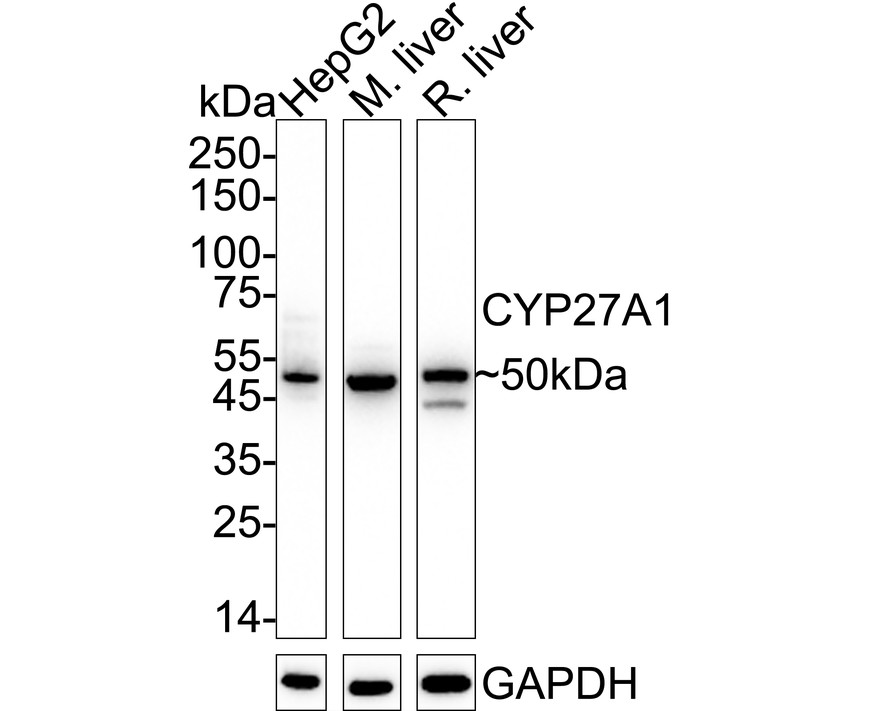
|
Fig1:
Western blot analysis of CYP27A1 on different lysates with Rabbit anti-CYP27A1 antibody (ET7109-05) at 1/1,000 dilution. Lane 1: HepG2 cell lysate (10 µg/Lane) Lane 2: Mouse liver tissue lysate (20 µg/Lane) Lane 3: Rat liver tissue lysate (20 µg/Lane) Predicted band size: 60 kDa Observed band size: 50 kDa Exposure time: Lane 1: 1 minute 2 seconds; Lane 2-3: 10 seconds; ECL: K1801; 4-20% SDS-PAGE gel. Proteins were transferred to a PVDF membrane and blocked with 5% NFDM/TBST for 1 hour at room temperature. The primary antibody (ET7109-05) at 1/1,000 dilution was used in 5% NFDM/TBST at 4℃ overnight. Goat Anti-Rabbit IgG - HRP Secondary Antibody (HA1001) at 1/50,000 dilution was used for 1 hour at room temperature. |
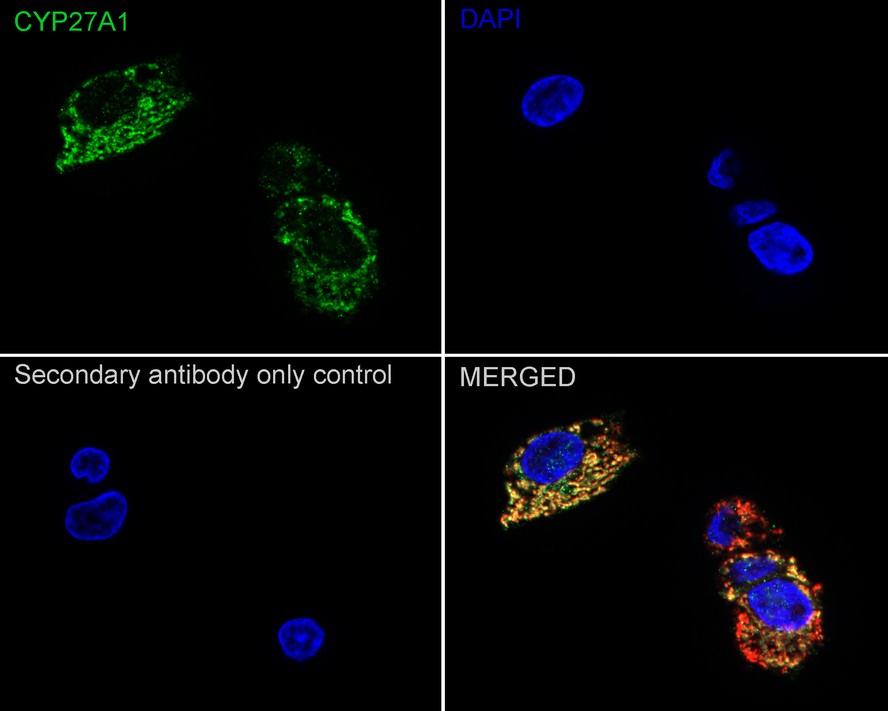
|
Fig2:
Immunocytochemistry analysis of HepG2 cells labeling CYP27A1 with Rabbit anti-CYP27A1 antibody (ET7109-05) at 1/100 dilution. Cells were fixed in 4% paraformaldehyde for 15 minutes at room temperature, permeabilized with 0.1% Triton X-100 in PBS for 15 minutes at room temperature, then blocked with 1% BSA in 10% negative goat serum for 1 hour at room temperature. Cells were then incubated with Rabbit anti-CYP27A1 antibody (ET7109-05) at 1/100 dilution in 1% BSA in PBST overnight at 4 ℃. Goat Anti-Rabbit IgG H&L (iFluor™ 488, HA1121) was used as the secondary antibody at 1/1,000 dilution. PBS instead of the primary antibody was used as the secondary antibody only control. Counterstained with Mitotracker. Nuclear DNA was labelled in blue with DAPI. |
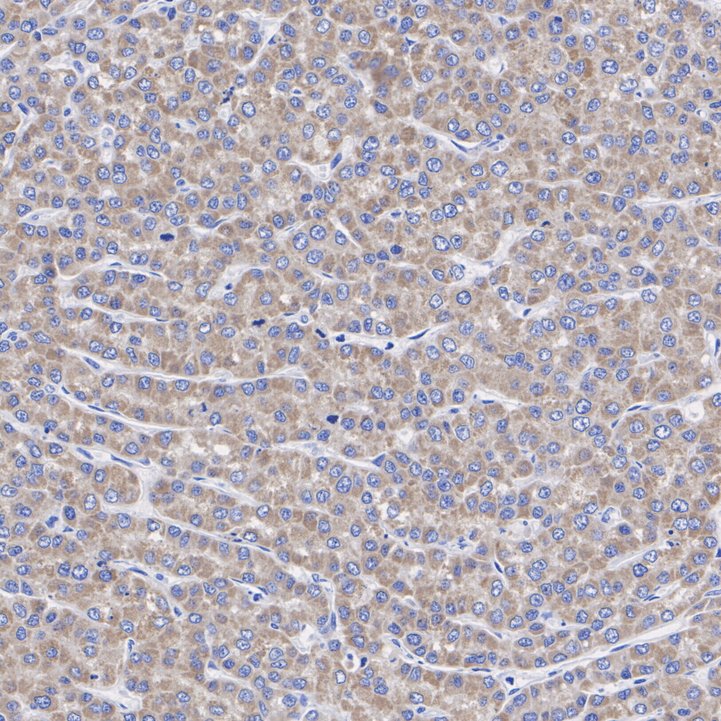
|
Fig3:
Immunohistochemical analysis of paraffin-embedded human liver cancer tissue with Rabbit anti-CYP27A1 antibody (ET7109-05) at 1/100 dilution. The section was pre-treated using heat mediated antigen retrieval with Tris-EDTA buffer (pH 9.0) for 20 minutes. The tissues were blocked in 1% BSA for 20 minutes at room temperature, washed with ddH2O and PBS, and then probed with the primary antibody (ET7109-05) at 1/100 dilution for 1 hour at room temperature. The detection was performed using an HRP conjugated compact polymer system. DAB was used as the chromogen. Tissues were counterstained with hematoxylin and mounted with DPX. |
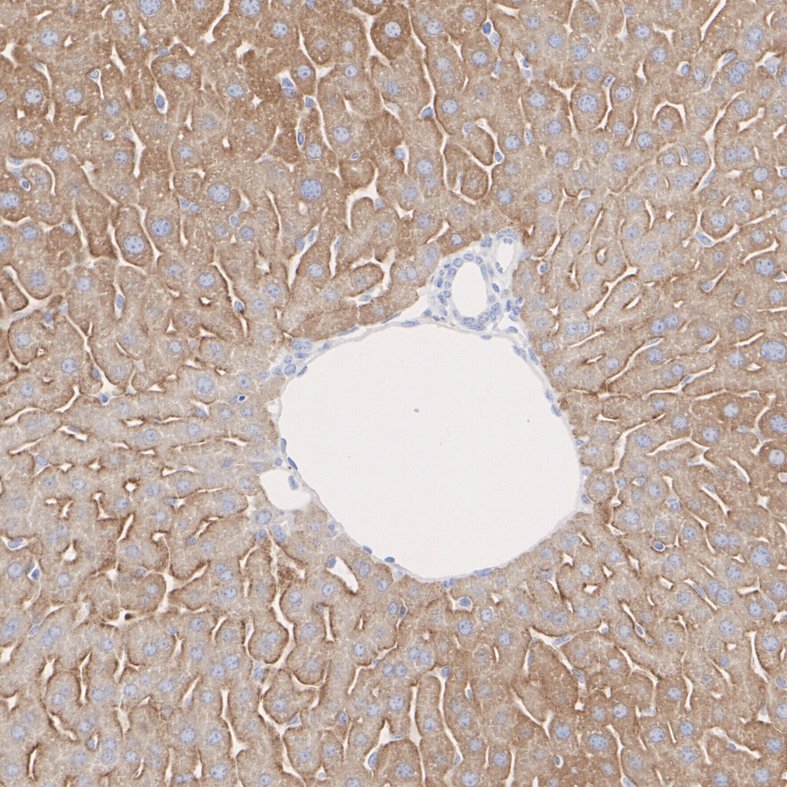
|
Fig4:
Immunohistochemical analysis of paraffin-embedded mouse liver tissue with Rabbit anti-CYP27A1 antibody (ET7109-05) at 1/100 dilution. The section was pre-treated using heat mediated antigen retrieval with Tris-EDTA buffer (pH 9.0) for 20 minutes. The tissues were blocked in 1% BSA for 20 minutes at room temperature, washed with ddH2O and PBS, and then probed with the primary antibody (ET7109-05) at 1/100 dilution for 1 hour at room temperature. The detection was performed using an HRP conjugated compact polymer system. DAB was used as the chromogen. Tissues were counterstained with hematoxylin and mounted with DPX. |
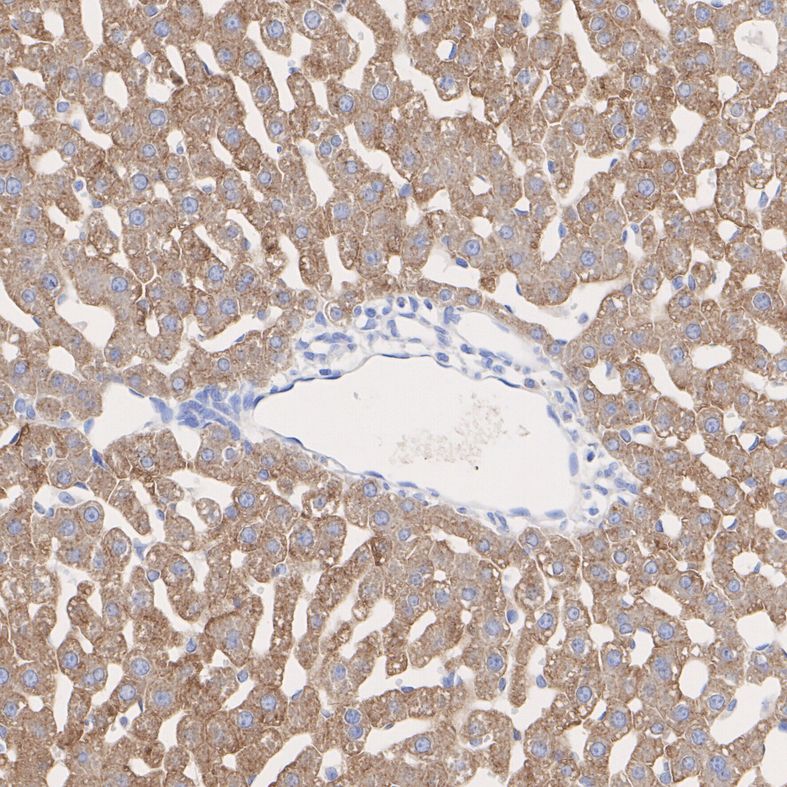
|
Fig5:
Immunohistochemical analysis of paraffin-embedded rat liver tissue with Rabbit anti-CYP27A1 antibody (ET7109-05) at 1/100 dilution. The section was pre-treated using heat mediated antigen retrieval with Tris-EDTA buffer (pH 9.0) for 20 minutes. The tissues were blocked in 1% BSA for 20 minutes at room temperature, washed with ddH2O and PBS, and then probed with the primary antibody (ET7109-05) at 1/100 dilution for 1 hour at room temperature. The detection was performed using an HRP conjugated compact polymer system. DAB was used as the chromogen. Tissues were counterstained with hematoxylin and mounted with DPX. |
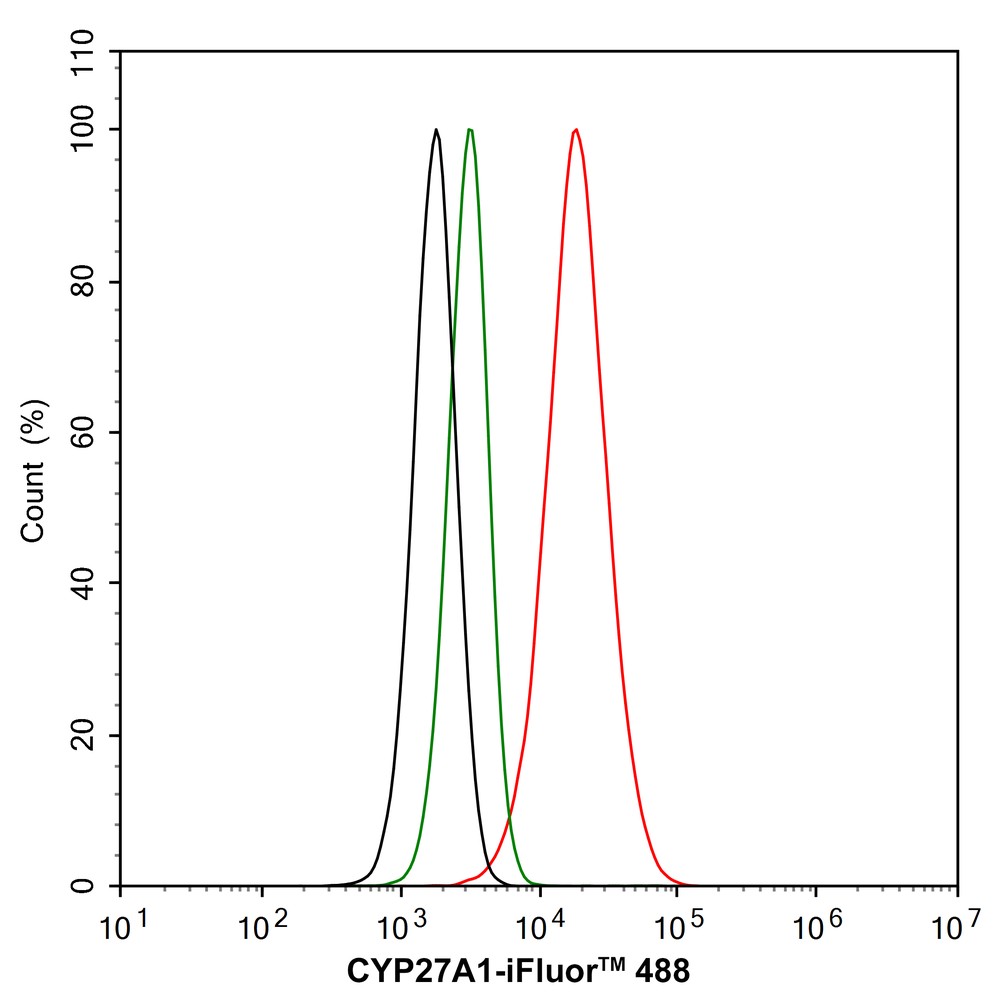
|
Fig6:
Flow cytometric analysis of HepG2 cells labeling CYP27A1. Cells were fixed and permeabilized. Then stained with the primary antibody (ET7109-05, 1/100) (red) compared with Rabbit IgG Isotype Control (green). After incubation of the primary antibody at +4℃ for an hour, the cells were stained with a iFluor™ 488 conjugate-Goat anti-Rabbit IgG Secondary antibody (HA1121) at 1/1,000 dilution for 30 minutes at +4℃. Unlabelled sample was used as a control (cells without incubation with primary antibody; black). |
Note: All products are “FOR RESEARCH USE ONLY AND ARE NOT INTENDED FOR DIAGNOSTIC OR THERAPEUTIC USE”.